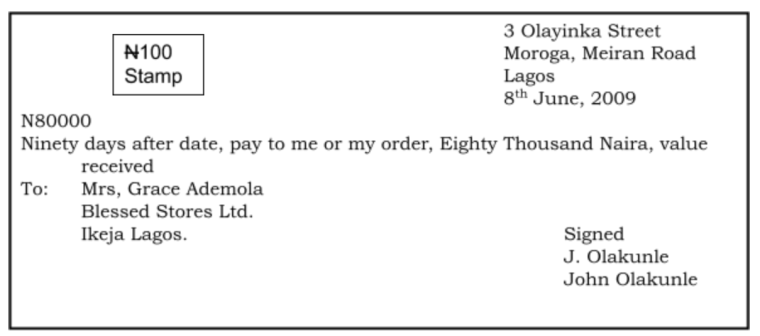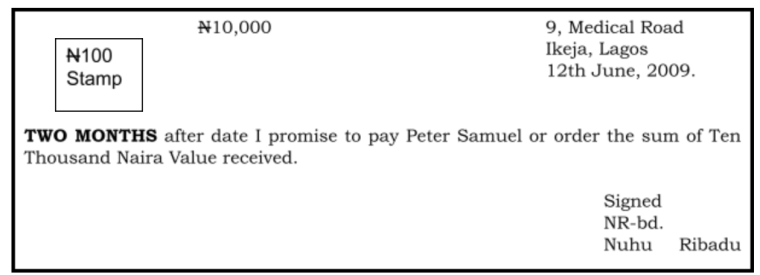SUBJECT: COMMERCE
CLASS: SS1
DATE:
TERM: 3RD TERM
WEEK 9
TOPIC: NEGOTIABLE INSTRUMENTS
CONTENTS
- Bill of exchange
- Dishonoured Bills
- Promissory Notes
NEGOTIABLE INSTRUMENTS
A negotiable instruments is an instrument whose title (or ownership) on it could be transferred by delivering it to another person with or without endorsement. Examples of negotiable instruments are bills of exchange, cheques, bank drafts, bill of lading, dividend warrants, treasury bills, bank notes and coins promissory notes debentures payable to bearer, bearer bonds, bill of lading etc.
BILL OF EXCHANGE
A bill of exchange is an unconditional order in writing, addressed by one person to another, signed by the person giving it, requiring the person to who it is addressed to pay on demand, or at a fixed or determinable future time a sum certain in money to, or the order of a specified person or to bearer.
In a simpler language, a bill of exchange refers to a written order issued to a buyer of goods (i.e. the debtor) by the seller of such goods (i.e. the creditor) asking for payment of sum of money at the end of a period of a time, usually three months.

Non-negotiable instruments
Dock Warrant, share certificate, postal order,
Money order, I.O.U
A debtor who receives a bill of exchange has to write the word “ACCEPTED”, his signature and date across the face of the bill and then return it to the sender (i.e. the drawer of that bill of exchange – the creditor or seller of the goods concerned).
PARTIES TO A BILL OF EXCHANGE
- The Drawer – the creditor or seller of the goods
- The Drawee – the debtor or buyer of the goods
iii. The Acceptor – usually the drawee of the bill
- The Payee – the person who receives payment of the amount stated on the bill. He is usually the drawer of the bill or the transferee (or endorse) if the bill is subsequently negotiated (transferred) to another person
- The endorser – this refers to the person who signs his name at the back of the bill before payment is made.
WAYS BY WHICH A BILL OF EXCHANGE CAN BE EXCHANGED FOR VALUE
- Keeping it till maturity: NB A bill which has been settled on the due date is called a “matured” bill.
- Negotiating or transferring it to another creditor
- Discounting it. The drawer of the bill may sell the bill to his bank earlier than the date specified (i.e. before the bill matures) and obtain cash for it. In this case the bank will pay cash that is less than the face value of the bill to the drawer (or endorsee)
TYPES OF BILLS
- Inland Bill: This is used in financing internal or home trade.
- Foreign Bill: This is a bill used in financing international trade. It is used as between the importer and exporter.
HOW A BILL OF EXCHANGE HELPS TRADE
- Short – Term Credit: A trader can obtain goods which he may sell at a profit before paying when the bills mature.
- A discountable Instrument: The holder can discount it with his bank. This means that the holders capital cannot be locked up in the bill for too long.
- A negotiable instrument: The drawer may transfer (i.e. negotiate) it to someone to whom he is indebted
- It has a fixed time for payment: The holder is sure of when the bill mature since the time for payment is duly fixed
- It offers flexibility in payments and terms of payment.
ADVANTAGES OF A BILL OF EXCHANGE
- It is a negotiable instrument
- It has a fixed date for payment
- It is a credit instrument. i.e. it is a means of short-term credit.
- It is a discountable instrument
- It provides a written acknowledgement of indebtness.
- It is a convenient means of payment.
DISHONOURED BILLS
To dishonour a bill of exchange means to either
- Refuse to accept it – dishonoured by non-acceptance or
- Refuse to pay when it falls due – dishonoured by non-payment.
STEPS TO BE TAKEN BY THE HOLDER OF A BILL WHEN THE BILL
IS DISHONOURED
- Noting: This is done by the holder of the bill to obtain formal (or official) proof that a bill has been dishonoured. He takes the bill to a notary public (i.e. a person usually a solicitor) who authenticates the fact that the bill if dishonoured.
The notary public or his clerk “notes” on the bill of exchange and records it in his register adding his initials (signature), date and noting charges.
Noting is just a preliminary to the next step – called a PROTEST.
- Protest: The protest is a formal certificate as to the dishonour. It is based upon the noting and specify the person at whose request the bill is protested, place and date of protest the reason for protesting the bill, the demand made and the answer (if any) given, or the fact that the drawee or accepter could not be found.
Difference Between a Bill of Exchange and a Cheque
| | Points | Bill of Exchange | Cheque |
1. | Drawer | The Creditor | The Debtor |
2. | Drawee | The buyer of goods | The bank |
3. | Payee | The drawer | The Creditor |
4. | Tine of Payment | Usually in the Future | Payable on demand |
5. | Acceptance | Has to be accepted | Not required |
6. | Crossing | No Crossing | May be crossed |
7. | Discounting | Can be discounted | Cannot be discounted |
8. | Noting and protesting in case of dishonour | Required | Not required |
OTHER TERMS CONNECTED TO A BILL OF EXCHANGE
- Days of grace: Bills may be payable on demand or at some future date. In the later case (.i.e. for bills payable at some future date) the bill is payable on the third day after the expiration of the term mentioned on it. These extra three days are called “days of grace”
- Retiring a bill: An acceptor may approach the holder of a bill for permission to pay before the due date. A bill taken out of circulation in this way is said to be retired. Usually the hider allows the accepter a “rebate”. Or “discount” for paying before the expiration of the term
PROMISSORY NOTES:
A promissory note is an unconditional promise in writing made by one person to another, signed by the maker engaging to pay on demand, or at a fixed or determinable future time, a sum certain in money to or to the order of a specified person, or to bearer.
Whereas the person to whom the debt is owed (i.e. the creditor) draws up the bill of exchange, the debtor himself draws up the promissory note. The bill of exchange is an order to the debtor to pay while the promissory note is a promise by the debtor to pay.

PARTIES TO A PROMISSORY NOTE
- The maker i.e. the debtor who promises to pay the money.
- The payee i.e. the creditor to whom the promise is made.
DIFFERENCE BETWEEN A PROMISSORY NOTE AND A BILL OF EXCHANGE
| | Bill of Exchange | Promissory Note |
1. | An order given by one person to another to pay money | A promise to pay money |
2. | Has to be accepted by the debtor | Acceptance is not required |
3. | The drawer is the creditor with secondary liability | The maker is the debtor with primary liability on the note |
4. | It is negotiable | It is not a good negotiable instrument |
5. | Protest necessary when a bill is unpaid | No protest is required |
REVIEW QUESTION
- Define a bill of exchange
- What is meant by the acceptance of a bill
- What is NOTING and PROTESTING as it relates to a bill of exchange.
WEEKEND ASSIGNMENT
- Which of the following cheques does not require endorsement (a) Specially crossed cheque (b) Open cheque (c) Bearer cheque (d) Generally crossed cheque.
- Which of the following is the most liquid (a) Bill of exchange (b) Promissory note (c) Money order (d) Open cheque
- A bill of exchange is made more negotiable it if has been (a) Endorsed (b) Accepted (c) Honoured instantly (d) Given special crossing.
- A bill of exchange sold for less than its face value before maturity is said to be (A) Accepted (b) Discounted (c) Dishonoured (d) Protested
- A cheque dated 5/2/08 but was dishonoured because it was (a) Post dated (b) Ante-dated (c) Stale (d) Order cheque
THEORY
- State four parties to a bill of exchange.
- List any four uses of bill of exchange in foreign trade.
READING ASSIGNMENT
- Essential Commerce for SSS by O.A Longe Page 283 – 287
- Comprehensive commerce for SSS by SSS by J. U. Anyaele Page 486 – 493
GENERAL EVALUATION QUESTIONS
- State eight features of hawking
- Explain seven characteristics of a sole proprietor
- Outline seven functions of the Central Bank
- State six essential features of a bill of exchange
- Give seven reasons why small scale retail businesses may fail

